Can You Bleach Hardwood Floors? Discover the Truth

Can you bleach hardwood floors? Beach is a powerful cleaning solution. So maybe it can work well on hardwood floors. Or it will eventually damage the floor. If you can use bleach on hardwood floors, what are the dos and don’ts? What are the side effects?
All of these questions will be discussed in this comprehensive article. Read it carefully, and you will be able to decide whether to bleach your precious hardwood floor or not.
What Is Bleach?
First of all, let’s learn a bit of bleach so that you can get a hint of how it works on hardwood floors.
Definition
Bleach is a widely-used cleaning agent. It is strong and can remove the most stubborn stains on floors, rugs, and clothes. Its active ingredient is sodium hypochlorite (1). Bleach comes in solid and liquid forms. But the liquid form is more frequently used.
Common Types Of Bleach
Do you know that there are different kinds of bleach? Let me show you what they are and their effect on hardwood floors.
Chlorine Bleach
This is the most commonly seen bleach in cleaning agents. It is a strong disinfectant and germ killer. It contains 5.25% of sodium hypochlorite. I have to warn you that this type of bleach is very likely to damage the hardwood floor. So try to avoid using it.
Oxalic Acid
Oxalic acid is the mildest kind of bleach. It is made of plan-based compounds. Therefore, it is the only bleach that is safe to use on the entire hardwood floor. It works best in removing rust stains.
Two-Part Bleach
This variety of bleach is called “two-part” because it has 2 components, namely hydrogen peroxide and sodium hydroxide. Two-part bleach is best known for the ability to alter wood’s color. You should be careful when using it.
Non-Chlorine Bleach
This type of bleach is very different from its other counterparts. It contains sodium percarbonate rather than sodium hypochlorite. So it is not as toxic as the others and quite environmentally-friendly. You may hear some people call it oxygen bleach.

Can You Bleach Hardwood Floors? The Ultimate Answer
I will go straight into the answer. Bleach is not an ideal cleaner for hardwood floors. Although hardwood floors are said to be very durable, it is sensitive to harsh cleaners, especially bleach. This strong cleaning agent can cause serious damage to your hardwood floor.
As such, if you have more options to choose from, don’t ever think of bleach. However, this applies when you intend to bleach the whole hardwood floor. In practice, you can bleach a small area of the floor, which has a stubborn stain on it.
Some factors decide whether a hardwood floor can be bleached or not. The first one is the type of finish. Surface finishes can endure bleach, while penetrating finish is much more sensitive to it.
The second one is the age of the hardwood floor. Newly installed hardwood floors can have less damage when interacting with bleach than old hardwood floors.
In addition, the type of bleach can also affect how it reacts on hardwood floors. Some types are milder and less toxic than others.

How Bleach Affects Your Hardwood Floors?
In this section, I will explain the potential risk you have to face when using bleach on your hardwood floor.
It Can Weaken The Wood’s Structure
When bleach seeps deeply into the hardwood floor, it destroys the connections between lignans, the compounds that makeup wood. As a consequence, the structural integrity of the hardwood floor becomes weaker over time, leading to creaking and splinters.
Bleach can also damage the floor finish.
It Can Discolor The Wood
The great amount of sodium hypochlorite in bleach can change the color of your hardwood floor. To be more specific, it lightens the color of the wood, just like what it does for clothes. You should be careful when using bleach on any area of the hardwood floor.

The Safe Methods To Use Bleach For Spot Cleaning On Hardwood Floors
Even though bleach is often not recommended for hardwood floors, you can use it to disinfect and spot clean the floor. But you must strictly follow the instructions to protect the hardwood floor from damage.
Option 1: Use Chlorine Bleach
For dyes, foods, tea, juice, and blood, chlorine bleach will be the most suitable cleaning solution.

What You Need
- Chlorine bleach
- Hot water
- Bucket
- Spray bottle
- Hard-bristle brush
- Rag
- Vinegar
- Cloth (or microfiber pad)
Step-by-step Instruction
Step 1: Add chlorine bleach into a bucket of hot water. Then pour the mixture into a spray bottle and spray it on the stained area.
Step 2: Use a hard-bristle brush to scrub the stain. Let it sit for roughly 10 minutes.
Step 3: Remove the stain using a clean rag. If the stain hasn’t been cleaned completely, repeat the procedure one more time.
Step 4: Apply a cup of vinegar to the stain. This will help to neutralize the bleach. Next, use clean water to rinse off everything.
Step 5: Use a clean cloth or microfiber pad to absorb as much liquid as possible. Let it dry completely.
Method 2: Use Oxalic Acid Bleach
Oxalic acid is very effective in removing rust stains, iron, and water-based stains such as pet urine, black ink.

What You Need
- Oxalic acid
- Hot water
- Rag
- Spray bottle
- Mop
- Borax
- Microfiber mop
Step-by-step Instruction
Step 1: Combine 2 tablespoons of oxalic acid and 4 cups of hot water. Wait until it dissolves. After that, transfer the mixture into a spray bottle and spray the stained area. Let it dry and spray another time if you like.
Step 2: Dampen the cloth with the cleaning solution and apply it to the nearby area to ensure that the stain is completely covered.
Step 3: Wait until the area dries. To make the process go faster, you can dry mop the floor.
Step 4: To neutralize the bleach, add 2 teaspoons of borax into 1 cup of hot water. Apply the mixture to the stain with a clean cloth.
Step 5: You’re done. Just wait for it to dry, or use a microfiber mop to dry it faster.
Method 3: Use Hydrogen Peroxide (And Sodium Hydroxide)
This type of bleach can remove organic stains, dyes, and inks. However, it can affect the color of the hardwood floor. Be careful when you use it.

What You Need
- Hydrogen peroxide
- Sodium hydroxide
- Spray bottle
- Cloth
- Hard-bristle brush
Step-by-step Instruction
Step 1: This type of bleach is very strong, so make sure you test it on a small area of the hardwood floor to see if any reaction occurs. If the floor is still fine, go ahead!
Step 2: Put hydrogen peroxide into a spray bottle. You can add sodium hydroxide if you want to. Next, apply the solution on the affected area by spraying.
Step 3: Let it sit on the stain for some time. If the area is too damp, utilize a cloth or microfiber pad to absorb some liquid.
Step 4: Use a hard-bristle brush to scrub the area until all of the stains are cleaned.
Step 5: Get a damp cloth and wipe away the stain. Use the same procedure if the stain has not been removed.
How To Bleach Finished Hardwood Floor
In case your hardwood floor has a layer of finish, you have to strip it before bleaching the floor and refinish it after you’ve finished. But make sure you pay attention to how the floor reacts as well as tightly stick to this instruction.
With this method, you can bleach a small area or the entire hardwood floor.

What You Need
- Bleach (oxalic acid)
- Sander or sandpaper (80-grit and 12-grit)
- Chemical stripping agent (optional)
- Lacquer (optional)
- Baking soda
- Paint remover (optional)
- Varnish remover (optional)
- Dust mop
- Hot water
- Stiff brush (or scrub brush)
- White vinegar (optional)
- Floor finish
Step 1: Clean The Floor
Whatever you want to do on the hardwood floor, clean it first. Use a dust mop to clean all of the dust and dirt.
Step 2: Remove The Current Finish
The next task is to strip the existing finish using a sander or a chemical stripping agent. It is best to use a sander rather than a chemical stripper because it is simple to use and not toxic like the stripper.
Another way is to use paint remover, varnish remover, or lacquer thinners, depending on what is available to use. Place some rags or paper towels all over the floor. Create a thick layer. Next, pour your chosen product on it until all of the rags or papers are damp.
When the old finish is softened, get a wood scraper or plastic spatula to remove it. Make sure you do not gouge the hardwood floor.
After you strip the floor, use sandpaper to make the hardwood floor smoother. Use 80-grit sandpaper first, then switch to 120-grit sandpaper.
Step 3: Test The Bleach On Hardwood Floor
Choose an unnoticeable area to test the effect of bleach on your hardwood floor, if no damage appears, you can proceed to the next step.
Step 4: Bleach The Hardwood Floor
If you wish to apply bleach on the entire hardwood floor. I recommend that you use oxalic acid because it is the most gentle one and can be safe for the hardwood floor.
Add 12 ounces of oxalic acid powder to 1 gallon of hot water. Apply the bleach solution all over the floor using a scrub brush, soft-bristle brush, or stiff brush and gently scrub the floor. Make sure the solution is always warm. Reheat it when necessary. Let the bleach sit for 10 minutes.
Note:
- Prepare yourself with eye protection when working with oxalic acid because it can be harmful to your eye.
- Wear gloves when making the oxalic acid solution. Use your hand or a wood stick to stir it.
- Do not use natural bristles. Avoid metal tools as well.
Step 5: Rinse The Hardwood Floor
Rinse the floor completely with clean distilled water. Using distilled water is very important because it helps to avoid iron stains.
Step 6: Neutralize The Hardwood Floor
There are two ways that you can decrease the effect of bleach on your hardwood floor. Since you’re using oxalic, mix 2 tablespoons of baking soda and 1 quart of hot water. White vinegar is also an option.
Step 7: Sand The Floor Again
After you neutralize the floor, let it dry for at least 1 day. Then sand it one more time with 120-grit sandpaper. This will help the floor to be smoother. You can apply a thin layer of lacquer on the floor before sanding.
Step 8: Refinish The Hardwood Floor
The final step is to reapply the floor finish to protect it from future damage. Choose a suitable sealer for your hardwood floor and apply it following the manufacturer’s directions.
Lastly, you should repeat the bleaching process as many times as necessary until the hardwood floor looks perfect.
Get yourself more ready with bleaching red oak hardwood floors!
Some Tips To Bleach Hardwood Floor Without Damaging it
To minimize the potential damage to the hardwood floor when bleaching, it is important that you always keep these tips in mind.
- Test the bleach on an area of the hardwood floor before bleaching it.
- Avoid using bleach on cedar, redwood, oak, cherry, and rosewood. It can discolor these types of hardwood floors.
- When you bleach hardwood floors, strictly follow the instructions on the label.
- Use protective clothes such as rubber gloves, a dust mask (or respirator), and safety glasses when bleaching.
- Use as little bleach as possible.
- Open the windows and turn on fans to ventilate the room.
- Keep your children and pets away from the floor.
- Prepare the neutralizer in a small container and put it somewhere nearby. When you accidentally spill some bleach on the hardwood floor. Apply it on the bleach.
- After bleaching, make sure you wash your hands carefully.
- Never pour bleach directly on the hardwood floor.
- Do not put rags and brushes in the same place. You’d better wash them right after they’re used or just throw them away.
- Never pour bleach into a metal bowl or bucket.
- Only prepare the bleach solution right before you bleach the hardwood floor.

FAQs
Finally, it’s time for questions and answers. The below questions are asked by many hardwood floor owners. You should read them one by one to get some more practical knowledge.
Try To Bleach Hardwood Floor As Less As You Can
As I have explained above, bleach can clean stains and lighten up your hardwood floor. However, the price can be high. The bleach’s overpowering nature may damage the floor.
Once you have no choice but to bleach your hardwood floor, do it with great care. Make sure you always follow the instructions and tips.
In case you have questions about this topic, feel free to type them in the comment box. I will get back to you soon.

References
- En.wikipedia.org.. Bleach – Wikipedia.
- Healthline.. Bleach and Vinegar: Effective Cleaning Tools That Turn Lethal Together.

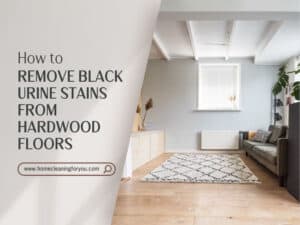
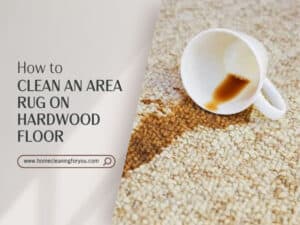
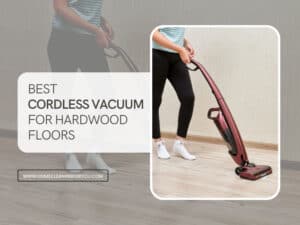
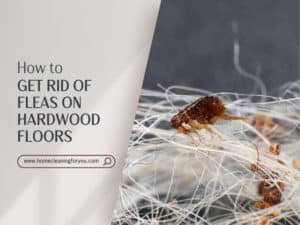
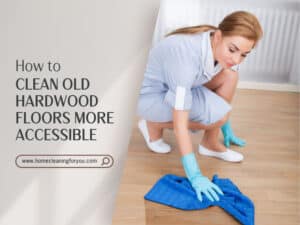
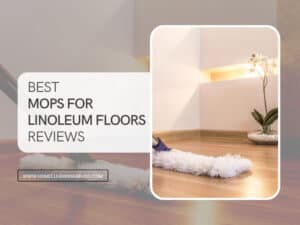
Samantha Lee
Head Cleaning Expert
Expertise
Professional Home Cleaning, Green Cleaning Techniques, Stain Removal & Fabric Care, DIY Home Maintenance & Organization, Sustainable Cleaning Products, Home Care for Busy Lifestyles
Education
University of Denver
Samantha Lee is the Head Cleaning Expert at HomeCleaningForYou.com, specializing in eco-friendly home care. She holds a Bachelor of Science in Environmental Science from the University of Denver, focusing on sustainable cleaning solutions.
With expertise in green cleaning, stain removal, and DIY home maintenance, she helps homeowners keep their spaces fresh and chemical-free. Samantha has been featured in lifestyle publications and has partnered with brands promoting natural cleaning products.
She also shares practical tips through her blog, online courses, and workshops. Passionate about sustainability, she enjoys testing new eco-friendly cleaning methods and spending time outdoors.